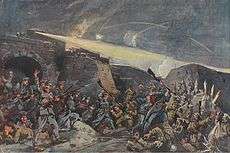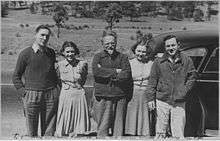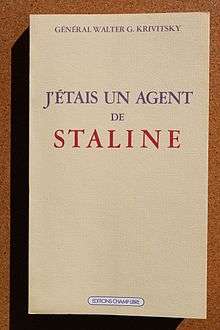Walter Krivitsky
Walter Germanovich Krivitsky (Ва́льтер Ге́рманович Криви́цкий; June 28, 1899 – February 10, 1941)[1] was a Soviet intelligence officer who revealed plans of signing the Molotov–Ribbentrop Pact before he defected, weeks before the outbreak of World War II.
Walter Krivitsky | |
|---|---|
 Walter Krivitsky in 1939 | |
| Born | Samuel Ginsberg June 28, 1899 |
| Died | 10 February 1941 (aged 41) Washington, DC, United States |
| Cause of death | bullet to the temple |
| Nationality | Austrian (first), French (last) |
| Occupation | spy, espionage, intelligence |
| Spouse(s) | Antonina ("Tonya Krivitsky," "Tonia Krivitsky," "Antonina Thomas") |
| Children | Aleksandr ("Alek") |
| Espionage activity | |
| Allegiance | Soviet Union |
| Service years | 1920-1937 |
| Codename | Walter Krivitsky |
| Codename | Walter Thomas |
| Codename | Walter Poref |
| Codename | Schoenborn |
| Codename | Val'ter Germanovich Krivitsky |
| Other work | Samuel Ginsburg, Samuel Ginzberg, Shmelka Ginsberg |
Early life

Walter Krivitsky was born on June 28, 1899, to Jewish parents as Samuel Ginsberg in Podwołoczyska, Galicia, Austria-Hungary (now Pidvolochysk, Ukraine), he adopted the name "Krivitsky," which was based on the Slavic root for "crooked, twisted". It was a revolutionary nom de guerre when he entered the Cheka, Bolshevik intelligence, in around 1917.
Espionage

Krivitsky operated as an illegal resident spy, with false name and papers, in Germany, Poland, Austria, Italy, and Hungary. He rose to the rank of control officer. He is credited with stealing plans for submarines and planes, intercepting Nazi-Japanese correspondence, and recruiting many agents, including Magda Lupescu ("Madame Lepescu") and Noel Field.
In May 1937, Krivitsky was sent to The Hague, Netherlands, to operate as the rezident (regional control officer), operating under the cover of an antiquarian. It appears that he co-ordinated intelligence operations throughout Western Europe.
Defection
At the time, the General Staff of the Red Army was undergoing the Great Purge in Moscow, which Krivitsky and close friend, Ignace Reiss, both abroad, found deeply disturbing. Reiss wanted to defect, but Krivitsky repeatedly held back.
Finally, Reiss defected, as he announced in a defiant letter to Moscow. His assassination, in Switzerland, in September 1937 prompted Krivitsky to defect the following month.
In Paris, Krivitsky began to write articles and made contact with Lev Sedov, Trotsky's son, and the Trotskyists. There, he also met undercover Soviet spy Mark Zborowski, known as "Etienne," whom Sedov had sent to protect him. Sedov died mysteriously in February 1938, but Krivitsky eluded attempts to kill or kidnap him in France, including flight to Hyères.[2]
As a result of Krivitsky's debriefing, the British were able to arrest John King, a cypher clerk in the Foreign Office. He also gave a vague description of two other Soviet spies, Donald Maclean and John Cairncross but without enough detail to enable their arrest. Soviet intelligence operation in the United Kingdom was thrown into disarray for a time.[3]
At the end of 1938, anticipating the Nazi conquest of Europe, Krivitsky sailed from France to the United States.
Anti-Stalinist
Krivitsky did not stop with defection; he went on to become an anti-Stalinist.[4]
In Stalin's Secret Service
With the help of journalist Isaac Don Levine and literary agent Paul Wohl, Krivitsky produced an inside account of Stalin's underhanded methods. It appeared in book form as In Stalin's Secret Service (UK title: I Was Stalin's Agent), published on November 15, 1939,[5][6] after appearing first in sensational serial form in April 1939 in the top magazine of the time, the Saturday Evening Post. (The title had appeared as a phrase in an article written by Reiss's wife on the first anniversary of her husband's assassination: "Reiss... had been in Stalin's secret service for many years and knew what fate to expect."[7]) The book received a tepid review by the very influential New York Times.[8]
Violently attacked by the American left, Krivitsky was vindicated when the German-Soviet Nonaggression Pact, which he had predicted, was signed in August 1939.
Testimony
Caught between dedication to socialist ideals and detesting Stalin's methods, Krivitsky believed that it was his duty to inform. That decision caused him much mental anguish, as he impressed on American defector Whittaker Chambers, as he told Chambers, "In our time, informing is a duty" (recounted by Chambers in his autobiography, Witness).[9]
Krivitsky testified before the Dies Committee (later to become the House Un-American Activities Committee) in October 1939, and sailed as "Walter Thomas" to London in January 1940 to be debriefed by Jane Archer of British Military Intelligence, MI5. In doing so, he revealed much about Soviet espionage. It is a matter of controversy whether he gave MI5 clues to the identity of Soviet agents Donald Maclean and Kim Philby. It is certain, however, that the People's Commissariat for Internal Affairs, Narodnyy Komissariat Vnutrennikh Del, abbreviated NKVD, learned of his testimony and initiated operations to silence him.
Death

Krivitsky soon returned to North America, landing in Canada. Always in trouble with the US Immigration and Naturalization Service, Krivitsky was not able to return there until November 1940. Krivitsky retained Louis Waldman to represent him on legal matters. (Waldman was a long-time friend of Isaac Don Levine.)
Meanwhile, the assassination of Trotsky in Mexico on August 21, 1940, convinced him that he was now at the top of the NKVD hit list. His last two months in New York were filled with plans to settle in Virginia and to write but also with doubts and dread.
On February 10, 1941, at 9:30 a.m., he was found dead in the Bellevue Hotel (now Kimpton George Hotel)[10] in Washington, DC, by a chambermaid, with three suicide notes by the bed. His body was lying in a pool of blood, caused by a single bullet wound to the right temple from a .38-caliber revolver found grasped in Krivitsky's right hand. A report dated June 10, 1941,[11] indicates he had been dead for approximately 6 hours.
According to many sources,[9][12] (including Krivitsky himself)[13] he was murdered by Soviet intelligence,[14] but the official investigation, unaware of the NKVD manhunt, concluded that Krivitsky committed suicide.[15][16]
People with close ties to Krivitsky later recounted opposite interpretations of his death:
- Suicide: Reiss' wife wrote:
In the United States, he had to make a new start in life, without knowing the country or the language. He did find friends, good friends, but among them he realized how frightfully alone he was... He lived in relative security and even affluence from the sale of his articles. His family was safe and well cared for, he had friends, it seemed he could start a new life. But something else had happened. For the first time he had the leisure to see himself in his new situation. He had broken with his old life and had not built a new one. He went to a hotel in Washington, wrote a letter to his wife and one to his friends, and put a bullet through his head... To those who knew his handwriting, his style, his expressions, there could be no doubt that he had written them.[17]
- Assassination: Chambers recounted in his memoirs:
One night one of my close friends burst into my office at Time. He was holding a yellow tear-off that had just come over the teletype.
"They have murdered the General," he said. "Krivitsky has been killed."
Krivitsky's body had been found in a room in a small Washington hotel a few blocks from the Capitol. He had a room permanently reserved at a large downtown hotel where he had always stayed when he was in Washington. He had never stayed at the small hotel before. Why had he gone there?
He had been shot through the head and there was evidence that he had shot himself. At whose command? He had left a letter in which he gave his wife and children the unlikely advice that the Soviet Government and people were their best friends. Previously, he had warned them that, if he were found dead, never under any circumstances to believe that he had committed suicide. Who had forced my friend to write the letter? I remembered the saying: "Any fool can commit a murder, but it takes an artist to commit a good natural death"...
Krivitsky also told me something else that night. A few days before, he had taken off the revolver that he usually carried and placed it in a bureau drawer. His seven-year-old son watched him.
"Why do you put away the revolver?" he asked. "In America," said Krivitsky, "nobody carries a revolver." "Papa," said the child, "carry the revolver."[9]
Victor Serge wrote in his notebook in 1944:
X., arriving from New York, confidentially assures me that the name of the GPU agent who assassinated Walter Krivitsky in a Washington hotel (winter 1940–1941) is known, as well as all the details of the affair. Nevertheless, the “suicide” version remains quasi-official.[18]
Speculation persists into the 21st century. For example, in 2017, Anthony Percy's book Misdefending the Realm (Buckingham: University of Buckingham Press, 2017[19]) argued that Krivitsky was the UK's most important source on Soviet plan, did not receive action from MI5 on the intelligence that he supplied, and was assassinated by Soviet intelligence after Guy Burgess informed Soviet superiors about him. The assassination, Percy argues, cleared the threat of exposure of the Cambridge Five and other moles.
Survivors
At the first news of his death, Whittaker Chambers found Krivitsky's wife, Antonina ("Tonia" according to Kern, "Tonya" according to Chambers) and son Alek in New York City. He brought them by train to Florida, where they stayed with Chambers's family, which had already fled New Smyrna. Both families hid there several months, fearing further Soviet reprisals. The families then returned to Chambers's farm in Westminster, Maryland. Within a short time, however, Tonia and Alek returned to New York.[9]
His wife and son both lived in poverty for the rest of their lives.[1] Alek died of a brain tumor in his early 30s after he had served in the US Navy and studied at Columbia University. Tonia, who changed her surname legally to "Thomas", continued to live and work in New York City until she retired to Ossining, where she died at 94 in 1996 in a nursing home.[1]
Works

- In Stalin's Secret Service (1939)[20] (second edition 1939,[21] 1979,[22] 1985,[23] 2000[24])
- Rusia en España (Spanish, 1939)[28]
- MI5 Debriefing & Other Documents on Soviet Intelligence (2004)[29]
See also
- GRU
- NKVD
- List of Eastern Bloc defectors
- List of KGB defectors
- Ignace Reiss
- Whittaker Chambers
- Louis Waldman
- Isaac Don Levine
- Paul Wohl
References
- Kern, Gary (2004). A Death in Washington: Walter G. Krivitsky and the Stalin Terror. Enigma Books. pp. early life 3–12, Paul Wohl 20–23, 172–175, 314–317, 420–424, 448–454, especially 245–246, family's fate and money 400–401. ISBN 978-1-929631-25-4.
- Krivitsky, Walter G. (1939). In Stalin's secret service: An Exposé of Russia's Secret Policies by the Former Chief of the Soviet Intelligence in Western Europe. New York: Harper Brothers. pp. 290, 294. LCCN 40027004.ISBN 0890935491 (1985)
- Lownie, Andrew (4 October 2016). Stalin's Englishman: Guy Burgess, the Cold War, and the Cambridge Spy Ring. 1878: St. Martin's Press.CS1 maint: location (link)
- Lewis, Flora (13 February 1966). "Who Killed Krivitsky?" (PDF). CIA. Washington Post and Times-Herald.
- "Book Notes". New York Times. 4 November 1939. p. 13.
- "Books Published Today". New York Times. 15 November 1939. p. 21.
- Reiss, Elsa (September 1938). "Ignace Reiss: In Memoriam". New International. pp. 276–278. Retrieved August 30, 2010.
- The New York Times and Joseph Stalin, David Martin, March 9, 2008.
- Chambers, Whittaker (1952). Witness. Random House. pp. 27, 36, 47, 59, 317–318, 381, 402, 436fn, 457, 459–463, informing 463, murder 207, 337, 485–486, fate of family 486-487. ISBN 0-89526-571-0.
- "The George Hotel". Kimpton Hotels & Restaurants. 2012. Retrieved 26 October 2012.
- "Venona: Soviet Espionage and The American Response 1939-1957 (footnote 18: Charles Runyon [Department of State], Memorandum for the File, "Walter Krivitsky," 10 June 1947)". Central Intelligence Agency. 1996.
- Hyde, Jr., Earl M. (July 2003). "Still Perplexed About Krivistky". International Journal of Intelligence and Counterintelligence. New York: International Journal of Intelligence and Counterintelligence (Volume 16, Issue 3): 431, 438. ISSN 1521-0561.
- Large, David Clay, Between Two Fires: Europe's Path In The 1930s, New York: W.W. Norton & Co. (1991), ISBN 0-393-30757-3, ISBN 978-0-393-30757-3, p. 308: Just prior to his death, Krivitsky confided to his friend Sidney Hook and others, "if I am ever found apparently a suicide, you will know the NKVD caught up with me."
- Secret murders ordered from the Kremlin (Russian), Interview with Nikita Petrov, historian and vice-president of Memorial Society, at Echo Moskvy,
- Knight, Amy W. (2006). How the Cold War Began: The Igor Gouzenko Affair and the Hunt for Soviet Spies. Carroll & Graf. pp. 304, n. 6. ISBN 0-7867-1816-1.
- "Files on Walter G. Krivitsky". Federal Bureau of Investigation.
- Poretsky, Elisabeth K. (1969). Our Own People: A Memoir of "Ignace Reiss" and His Friends. London: Oxford University Press. pp. 269–270. LCCN 70449412.
- Serge, Victor (2019). Notebooks 1936—1947. New York: New York Review Books. p. 401. LCCN 2018029769.
- "Misdefending the Realm". University of Buckingham Press. 2017. Retrieved 27 October 2017.
- Krivitsky, Walter G. (1939). In Stalin's Secret Service: An Exposé of Russia's Secret Policies by the Former Chief of the Soviet Intelligence in Western Europe. New York: Harper Brothers. LCCN 40027004.
- Krivitsky, Walter G. (1939). In Stalin's Secret Service: An Exposé of Russia's Secret Policies by the Former Chief of the Soviet Intelligence in Western Europe. New York: Harper Brothers. LCCN 49034777.
- "In Stalin's Secret Service". Library of Congress. 1979. p. 273. Retrieved 23 February 2014.
- "In Stalin's Secret Service". Library of Congress. 1985. p. 273. Retrieved 23 February 2014.
- In Stalin's Secret Service. Library of Congress. 2000. pp. 306. ISBN 1929631030. Retrieved 23 February 2014.
- "Agent de Staline". Library of Congress. Retrieved 23 February 2014.
- "Byłem agentem Stalina". Library of Congress. Retrieved 23 February 2014.
- "Я был агентом Сталина. Записки советского разведчика". Терра-Terra.
- "Rusia en España". Buenos Aires: Library of Congress. c. 1939. p. 31. Retrieved 23 February 2014.
- Krivitsky, Walter G. (2004). Kern, Gary (ed.). MI5 Debriefing & Other Documents on Soviet Intelligence. Xenos Books. ISBN 1-879378-50-7.
Sources
- Chambers, Whittaker (1952). Witness. Random House. ISBN 0-89526-571-0.
- Hyde, Jr., Earl M. (July 2003). "Still Perplexed About Krivistky". International Journal of Intelligence and Counterintelligence. New York: International Journal of Intelligence and Counterintelligence (Volume 16, Issue 3). 16 (3): 428–441. doi:10.1080/713830442. ISSN 1521-0561.
- Kern, Gary (2004). A Death in Washington: Walter G. Krivitsky and the Stalin Terror. Enigma Books. ISBN 978-1-929631-25-4.
- Poretsky, Elisabeth K. (1969). Our Own People: A Memoir of "Ignace Reiss" and His Friends. London: Oxford University Press. LCCN 70449412.
- "Files on Walter G. Krivitsky". Federal Bureau of Investigation (FBI). n.d. Retrieved September 11, 2010.